Want to make your Monstera grow bigger, healthier, and at a faster rate?
A fertiliser provides your Monstera with the nutrients it needs to grow faster, bigger and healthier. Choosing the best fertilizer for your Monstera is critical because, as a houseplant, it grows in a small amount of soil that will get depleted.
In this blog post, I will break down the best types of fertilisers, and answer some common Monstera nutrients and fertiliser questions.
Monstera Nutrients
Plants must obtain the following mineral nutrients from their growing medium (source):
- Macronutrients: They are fundamental nutrients for building any healthy plant.
- Macronutrients include: nitrogen (N), phosphorus (P), potassium (K), calcium (Ca), sulfur (S), magnesium (Mg), carbon (C), oxygen (O), and hydrogen (H).
- Among them, nitrogen, phosphorus, and potassium are the most important ones since plants need them in a higher quantity.
- Calcium, sulfur, and magnesium are considered secondary macronutrients since they are needed in less quantity.
- Finally, plants will absorb carbon, oxygen, and hydrogen from the air and water.
- Micronutrients (or trace minerals): Plants use micronutrients in small quantities.
- Micronutrients include: iron (Fe), boron (B), chlorine (Cl), manganese (Mn), zinc (Zn), copper (Cu), molybdenum (Mo), and nickel (Ni).
So, what helps Monstera thrive?
There are three primary macronutrients that all plants need: Nitrogen, Phosphorous, and Potassium. These are labelled using their chemical abbreviations N, P, and K.
Monstera plants, like most foliage plants, need nutrients in a 3-1-2 N-P-K ratio. This means three parts nitrogen to one part phosphorus to two parts potassium.
These three macronutrients contribute to your plant’s leaves, stem, and root health. They also help with fenestration development (i.e. they help Monstera leaves split).
Among the three, nitrogen is the most important since it’s necessary for leaf growth. That’s why it has the highest number in the ratio.
| MONSTERA NUTRIENTS | MACRONUTRIENTS FUNCTIONS |
|---|---|
| Nitrogen | – Formation of proteins. – Essential for photosynthesis. – Promotes new leaves. – Helps with leaves splitting (fenestration). |
| Phosphorous | – Key to photosynthesis. – Encourages root growth. – Responsible for flowering and setting seeds. |
| Potassium | – Helps regulate water intake. – Boosts immune system. |
To find the N-P-K ratio, look for a series of numbers on the fertilizer. Any 3-1-2 ratio fertilizer will have a first number that’s three times the second number and a third number that’s two times the second number.
To clarify that, here are some examples that meet the 3-1-2 ratio:
- 3-1-2
- 6-2-3
- 9-3-6
- 12-4-8
- 15-5-10
- 18-6-12
- 21-7-14
The difference in these ratios is the concentration of nutrients. Higher numbers mean that the fertiliser has a higher concentration, so you will need to dilute it (if liquid) or mix a smaller amount into your water.
Apart from those three macronutrients, balanced fertilisers will also contain secondary macronutrients and micronutrients.

Monstera Fertiliser Needs
All plants need two things to grow up big and strong: energy and nutrients.
Plants make their energy from water, carbon dioxide, and sunlight. However, they also require nutrients to help them complete the necessary processes to grow healthy.
In nature, plants have access to all kinds of nutrients through the soil, rainwater and air. But indoors, they have access to a limited amount of soil inside their pot.
Even if you use a soil mix that contains compost or nutrients, plants will eventually use up these nutrients and require fertilizer. This means that you will need to add those nutrients back to the soil in the form of fertilizer.
Why Does Monstera Need Fertiliser?
Monsteras can grow very large, even indoors. A Monstera Deliciosa, for instance, can get 6 to 10 feet (1.8 to 3m) tall, depending on the size of the pot, lighting conditions, and access to nutrients.
Although most potting soil is fortified with nutrients, after 6 to 12 months of living in the same pot and soil, Monsteras deplete all the available nutrients and run out of what they need to thrive.
So, when growing Monsteras indoors, they (and other houseplants) depend on you to provide the necessary nutrients.
Monsteras need fertiliser to replenish the nutrients in the soil mix, which allows them to grow bigger and healthier, putting out new leaves, including fenestrated ones.
But, how do you know if your Monstera needs fertiliser or if it’s over-fertilised?
Let’s have a look at the signs for both scenarios.
Signs Your Monstera Needs Fertiliser
In a nutshell, yellow spotting and slow or stunted growth can be signs of a Monstera needing fertilizer.
Let’s take a closer look at how Monsteras will let you know that they need more nutrients.
Signs of Monstera nutrient deficiency include:
1) Yellow Spotting On The Foliage
Yellow spots, called chlorosis, can be a sign that your Monstera needs fertiliser.
But there are other reasons why your Monstera might develop yellow spots, such as overwatering, low humidity, dry soil, lack of sunlight, and pest infestation.
Also, depending on the age of your Monstera plant’s foliage, yellowing can be a natural progression of its life cycle. Older leaves will eventually turn yellow and fall off.
So it’s important to pay attention to the whole plant and what changes are happening throughout before determining the cause.
Insider Tip: Both Monstera Adansonii and Monstera Deliciosa are known to display yellow spots when they do not have enough nutrients to sustain their rapid growth.
Variegated Monsteras, although grow less quickly, they can also display yellow spot signs when they need more nutrients.
2) Slow Or Stunted Growth
Slow or stunted growth is also a sign that your Monstera has nutrient deficiency and needs fertiliser. In fact, your plant may stop growing completely if it doesn’t have access to more nutrients.
Outside of the dormant season (autumn and winter months in the northern hemisphere), your Monstera plant should grow at a steady speed during the spring and summer months.
If you notice your Monstera hasn’t grown at all during its growing season, it’s possible it needs to replenish its nutrients to support new growth.
Ideally, you should be feeding your Monstera during the growth season (discover more on when you should fertilise Monsteras further down as you continue reading).
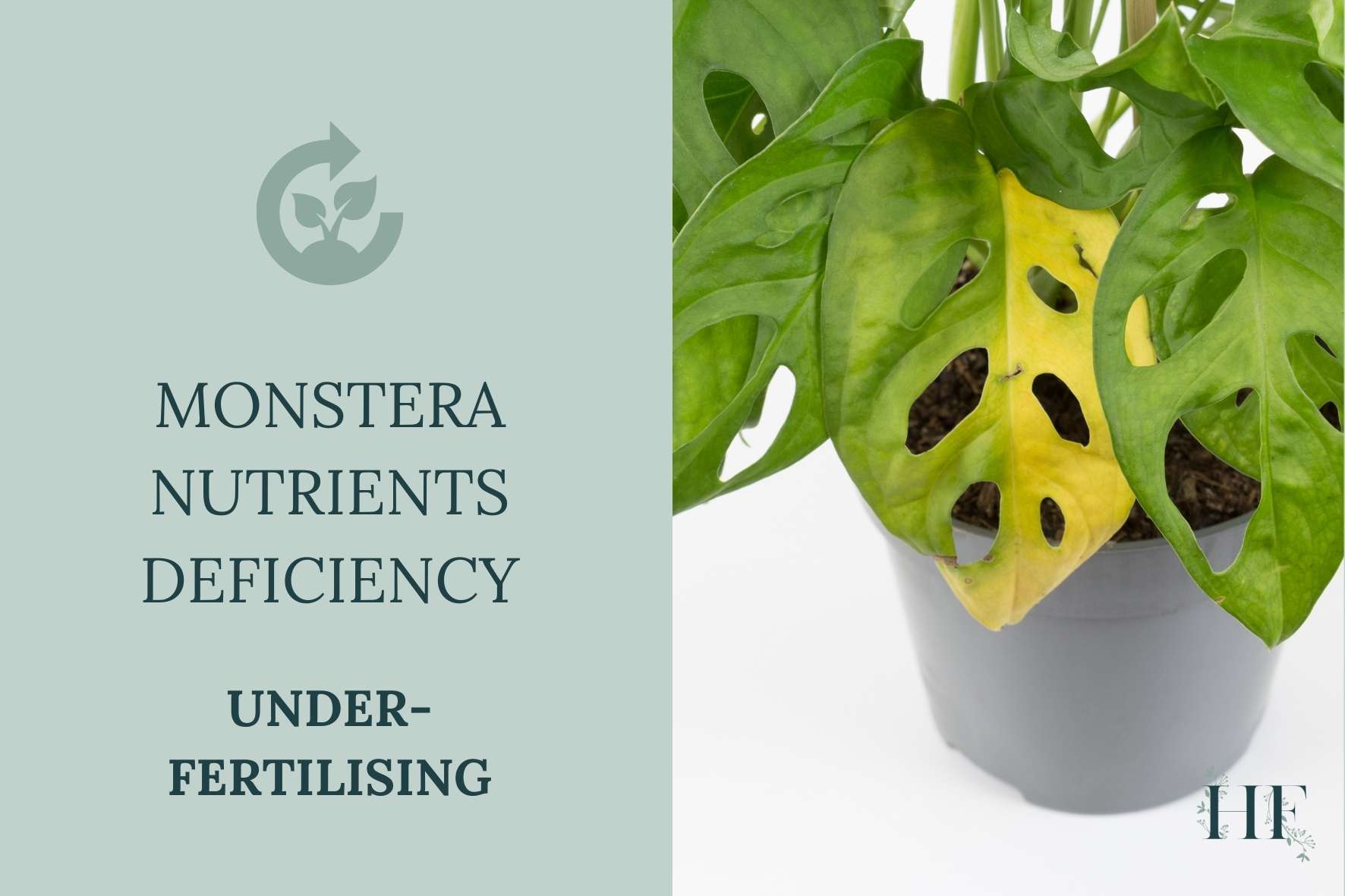
Signs Your Monstera Deliciosa Is Over-Fertilised
Your Monstera can also tell you when to stop fertilising. Too much fertiliser can damage your Monstera, and this is referred to as fertiliser burn.
When your Monstera suffers from fertiliser burn, your plant’s roots get damaged by too much fertiliser. Once the roots are damaged, the leaves may start to die as well, appearing droopy and crispy.
Here are the signs of Monstera being over-fertilised:
1) White Crust On The Soil
One common sign of over-fertilising is a white crust on the top of the soil. This crust is caused by a build-up of salts found in fertilisers.
It doesn’t matter what type of fertilizer you are using – organic fertilizer, granular fertilizer, or synthetic fertilizer – they will all cause salt build-up if used too often.
2) Wilting Leaves
Wilting leaves are not only a sign of a lack of available nutrients, they can also be a sign you have been giving your Monstera too much fertiliser.
If you have been regularly feeding your plant and spot wilting leaves, stop fertilising immediately to give your Monstera a chance to recover.
3) Yellow Leaf Edges that Turn Brown
If the leaf edges of your Monstera turn yellow and then brown, it’s highly likely you have been over-fertilising your plant.
If you spot yellow edges on your Monstera’s leaves, you will need to lower the dose of the fertiliser that you have been using or stop fertilising for a while.
4) Stunted Growth
Another sign that can hint towards both too under and over-fertilising is seeing your Monsteras growth slowing down or stopping altogether.
If you spot stunted growth and another over-fertilising sign, it’s best to stop adding fertilising for a while to let your Monstera recover.
Many of these signs are similar to the symptoms of other types of Monstera problems, such as damage from root binding and overwatering, which can be confusing.
So, it’s important to pay attention to how you care for your Monstera. For more insights on common Monstera issues, you can check the Monstera Problems blog post.
However, if you think that you have over-fertilised your Monstera, you can flush the excess fertiliser out by running water through the plant’s soil until it drains.
Rinsing the excess fertiliser out of the soil is the best way to treat a Monstera that has too much fertiliser. You can repeat this process several times if necessary.
Afterwards, just make sure that your Monstera plant dries thoroughly before the next watering to avoid overwatering.
Repotting your Monstera to get rid of excess fertiliser should be the last resort since repotting can further damage its roots. Also, check my Which Type of Soil Is Best for Monstera? blog post for a Monstera repotting soil recipe.
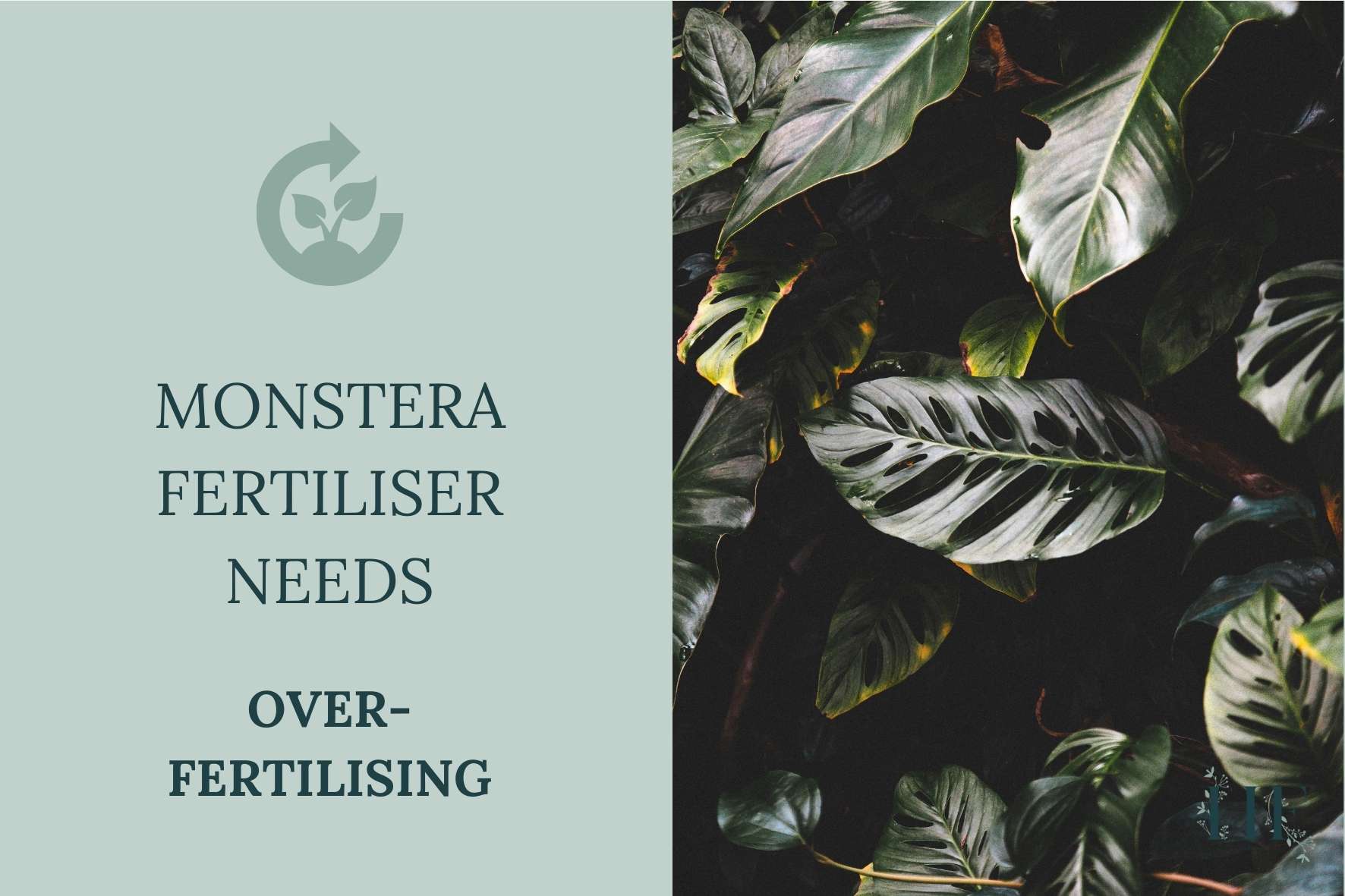
When To Fertilize Your Monstera?
As a rule of thumb, you should apply fertiliser when your plants are actively growing (referred to as the growing season) and avoid fertilizing when your plants have slowed their growth (i.e., they have gone dormant, hence dormant season).
You can fertilise your Monstera once a month or every two weeks during its growing season (the spring and summer months, from April to September, in the northern hemisphere). This recommendation is based on an organic liquid fertiliser with a 3-1-2 N-P-K ratio.
Once it starts to get a bit colder and your Monstera enters its dormant season, you will not want to fertilise your plant (or any of your houseplants, for that matter).
Should You Fertilise Monstera in Winter?
Since Monsteras are not actively growing during winter, they don’t need fertilising.
It’s not necessary to fertilise your Monstera in autumn or winter (in the northern hemisphere) since they are in their dormant season. This means, their growth has slowed down or completely stopped due to lack of sunlight and colder temperatures.
In this case, you should wait until spring to start fertilising again.
The exception to this rule is if you use a grow light for your Monstera. Full-spectrum grow lights provide the right quantity and quality of light all year round. This means that you can keep the light/dark cycle consistent, and your Monstera plant will continue to grow in the winter months. If this is the case, you can fertilize all year round.
Remember that your watering schedule and your fertilising schedule should depend on the environment your Monstera is growing.
How Often Should You Fertilise a Monstera?
The frequency of fertilising your Monstera will depend on the type of fertilizer and the soil potting mix you are using.
Here are some guidelines for feeding frequency depending on the type of fertiliser:
| TYPE OF FERTILISER | FREQUENCY |
|---|---|
| Mild water-based fertilisers like Liquidirt | Every watering. |
| Worm casting tea | Every watering. |
| Stronger fertilizers | Once every two weeks. |
| Soil additive fertilizers | Every few months. |
Before fertilising your Monstera, read the manufacturer’s guidelines on how often and how much to fertilise your plant.
Insider Tip: Be careful with the ratios (a.k.a. nutrient concentration) of your fertiliser. Liquid fertilisers and inorganic fertilisers usually need to be diluted. If you don’t dilute, you will cause damage to your plant’s roots.
In terms of the potting mix, if you are using soil that already contains fertiliser, such as Miracle-Gro, check the bag to see how long this fertiliser will last. Wait for that length of time to pass before you start adding additional fertiliser to your Monstera’s soil.
Monsteras planted in soil-less mediums like perlite or LECA, need more frequent fertilisation. These types of mediums do not contain any nutrients such as organic matter, and they do not hold nutrients as well as regular soil. As a result, you will need to fertilise more often. You are likely to use these mediums when propagating a Monstera stem.
If you are using a ready-to-go mix of coco coir and perlite and your choice of potting mix for indoor plants, you might need to fertilise twice a week instead of once a month due to the inorganic medium content (perlite).
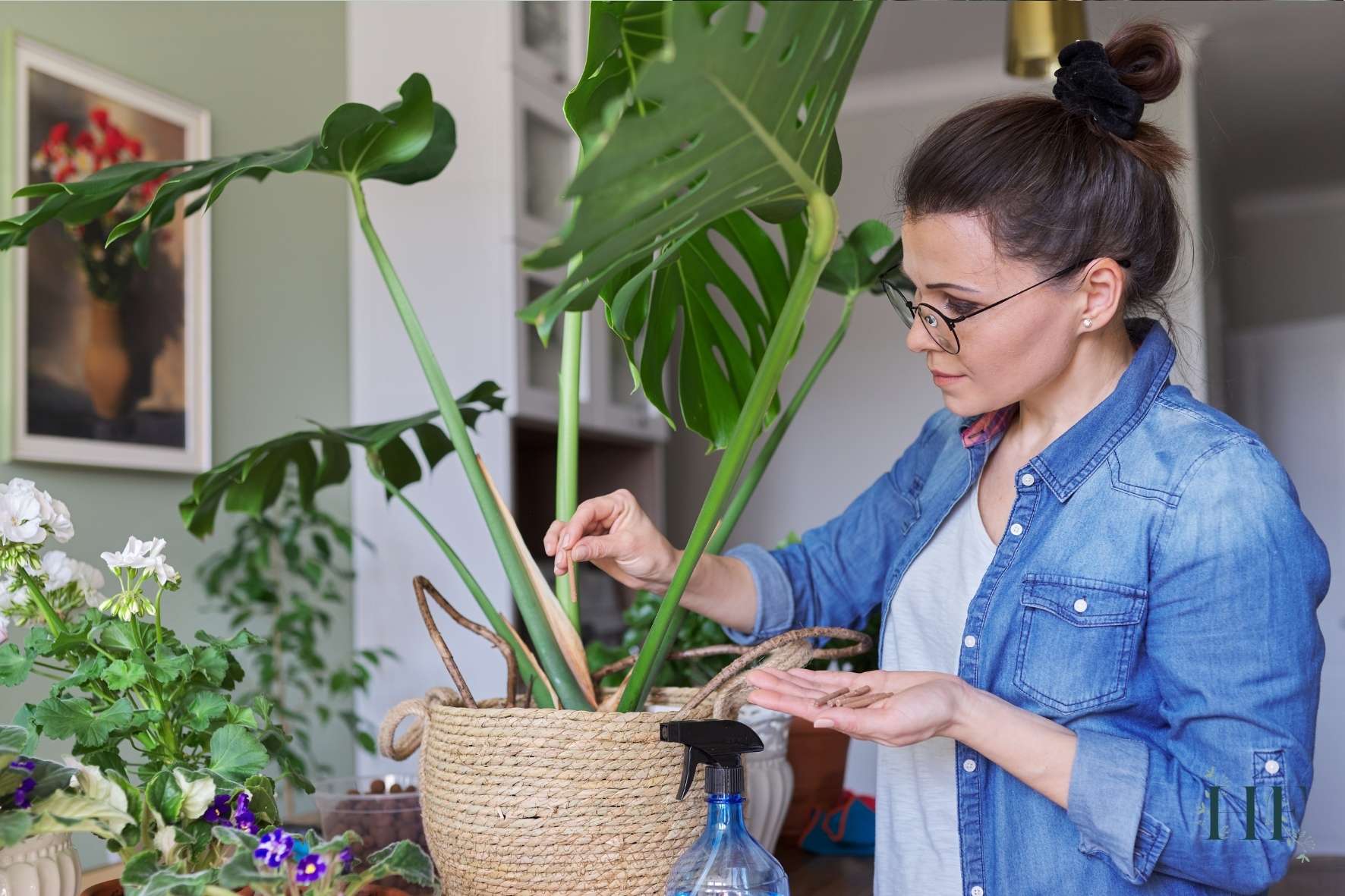
Types of Fertilisers for Monstera
There are lots of options when you go to fertilise your Monstera, including:
- Compost.
- Organic liquid fertiliser.
- Slow-release fertiliser.
- Granular fertiliser.
- And synthetic fertiliser.
You don’t need to buy fertiliser specifically for Monsteras to keep your plant thriving. Instead, you choose one with the complete set of nutrients to meet your Monstera’s requirements.
Which Fertiliser Is Best for Monstera?
Following the 3-1-2 N-P-K ratio, the best fertiliser for Monstera plants is a liquid fertiliser because they give a steady supply of nutrients in the soil and you can easily dilute them in water.
Also, since a liquid fertiliser is added to the water (either in liquid or powder form), you have total control over when to feed your Monstera.
Plus, you can choose an organic liquid fertiliser instead of a synthetic one, if that aligns more with your views.
Is Organic or Synthetic Fertiliser Best for Monstera?
There are two types of fertilisers depending on their ingredients:
1) Organic Fertilisers
Organic fertilizers are the ones that have naturally decaying material from plants or animals and some rock minerals. They tend to be slower acting and lower in nutrients than synthetic fertilisers.
Some materials commonly used in organic fertilisers include composted manure, rock dust, bone meal, blood meal, and seaweed.
Here are the pros and cons of organic fertilisers:
| Pros of organic fertilisers | Cons of organic fertilisers |
|---|---|
| Improves soil structure and ability to hold water and nutrients, favouring the growth of microbes. | Are less effective because nutrient release depends on microorganisms that need warmth, moisture, and other favourable conditions. |
| Environment-friendly and sustainable, meaning they will not affect water quality or harm marine life. | Take a little longer to show effects, meaning they will start working after a breakdown in the soil. |
| Unlikely to damage roots since they don’t have toxic chemicals or acids. | More expensive than synthetic ones and not always available. |
| Released slowly, so you are unlikely to over-fertilise your plant. | Not equally created, meaning you will get a lot of inconsistencies depending on which one you buy. |
As a guideline, you could use an organic fertiliser if you:
- Are okay with applying a weaker fertiliser more frequently.
- Are worried about damaging your plants by over-fertilising.
- Have an unhealthy, young, or rooting Monstera cutting that needs a weaker fertiliser.
- Want to create a healthy microbiome in your soil where microbes break down the organic fertiliser.
Among organic fertilisers, you can get:
1.1) Organic Liquid Fertiliser
When choosing an organic liquid fertiliser, I recommend LiquiDirt since you can use it for watering and also for propagation!
Apart from being great to feed an established plant, LiquiDirt is a good choice as a Monstera in water fertiliser since it helps Monstera cuttings to develop strong root systems faster than growing them with plain water.
Plus, it’s safe for pets, has no smell, doesn’t expire and is impossible to mess up because it cannot burn plants. You only have to dilute one cap (around 20ml or 2 teaspoons) into a gallon of water (1 gallon is 4.5 litres or 8 pints, which is usually the capacity of a regular watering can).

1.2) Worm Castings
Worm castings are the result of worms eating their way through the soil. It’s made of worm droppings and has no smell.
This organic fertiliser can be used in a couple of ways. You can add worm castings to the soil as a top dressing by sprinkling them on top of the soil. You can add a thin layer (half cup) over the surface of the soil every three months: early spring, early summer and early autumn.
Alternatively, you can make worm casting tea by steeping them in water overnight. This brew is rich in nutrients and it doesn’t need to be further diluted.
Finally, you can add worm castings to the soil mix when repotting your Monstera plant.
I recommend this organic worm castings fertiliser.
1.3) Compost
For a homemade Monstera fertiliser, choose compost. It is a great fertiliser for any indoor and outdoor plant.
Nowadays, you don’t need a garden or balcony to do compost at home. You don’t need even a compost pile, for that matter. You can create your homemade fertiliser using food scraps.
Electric home food recyclers or composters like Vitamix FoodCycler can transform most table and refrigerator scraps including chicken bones into fertiliser.
Apart from being sustainable, compost is easy to use since all you need to do is add compost to the soil as it is. You can either layer the compost on top of the soil or mix it into the soil around your Monstera plant.
In reference to the monstera fertiliser N-P-K ratio, it’s a little different with compost. To keep your compost well-balanced, you need to pay attention to the carbon-rich browns and nitrogen-rich greens.
The best formula is to have thirty parts carbon (browns) to one part nitrogen (greens). This ensures that the microorganisms that power your compost have a nice, balanced diet.
- Brown ingredients: Dried grass clippings, woody plant material, pine needles, oats, grains, feedstock, autumn leaves, sawdust, wood chips, straw, hay, uncooked pasta, and shredded paper (such as thin cardboard and newspaper, not magazines).
- Green ingredients: Table scraps, fruits, veggies, leftovers and fresh grass clippings.
This formula applies to an electric home composter or a traditional composter.
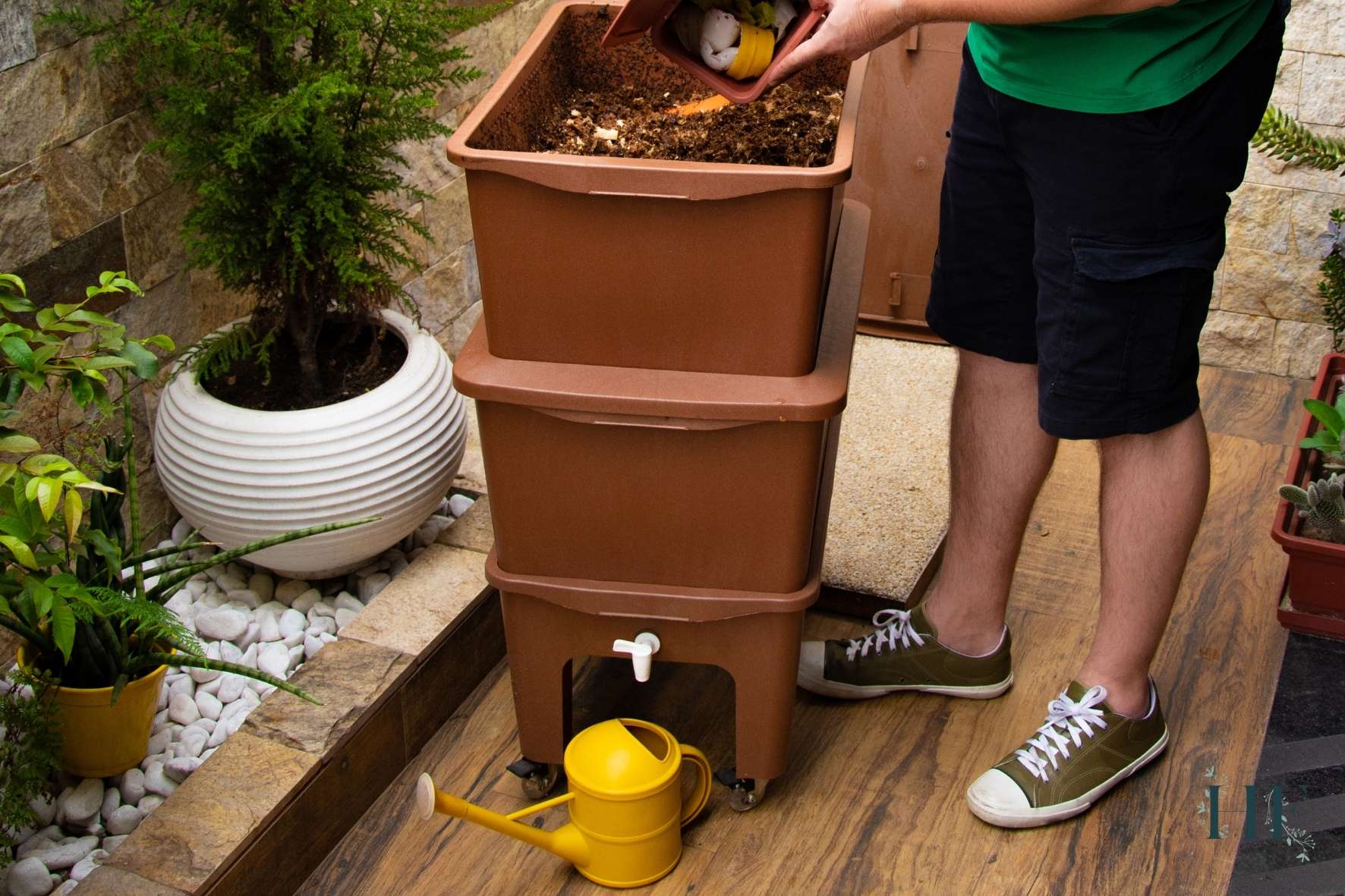
2) Synthetic Fertilisers
Synthetic fertilisers, also referred to as inorganic or chemical fertilisers, have mined minerals and synthetic chemicals. These fertilisers have a quick release.
Examples of some of their ingredients include ammonium phosphate, ammonium nitrate, and potassium chloride.
Here are the pros and cons of synthetic fertilisers:
| Pros of synthetic fertilisers | Cons of synthetic fertilisers |
|---|---|
| Affordable and readily available. | Easier to over-fertilise since they release nutrients quickly and are more concentrated (stronger). |
| Give fast results, meaning you will notice results in a few days to weeks and not months since they contain nutrients that are ready (for the plant) to drink. | They are not eco-friendly, meaning their chemicals cause water pollution. |
| Have standard labelling, meaning you know exactly what they contain. | Don’t improve soil structure and health, or support microbes as they don’t have any organic matter. |
| Convenient to use since they are easy to use and the process doesn’t take much of your time. | Long-term use may result in a buildup of harmful chemicals and alter soil pH. |
As a guideline, you could use a synthetic fertiliser if you:
- Want a stronger fertiliser that will give immediate results and maximum growth.
- Are prepared to carefully follow directions to apply it correctly.
- Are using a soilless medium like perlite or LECA to grow your Monstera and it needs nutrients.
2.1) Synthetic Liquid Fertilizer
If you decide to go for a synthetic fertiliser, I recommend Dyna-Gro Foliage-Pro 9-3-6 ratio for Monstera and other foliage houseplants. Just bear in mind that its nutrient ratio is stronger than 3-1-2.
Also, when using a fertiliser with a higher concentration of nutrients, it’s recommended to dilute to avoid burning your plants. Usually, most liquid fertilisers (including Dyna-Gro) recommend mixing one or two teaspoons into one gallon (4.5 litres or 8 pints) of water for a monthly feeding.
As you can see, you need just a tiny amount of fertiliser for each watering!
Insider Tip: If it’s your first time using a fertiliser or the first time you are trying a particular fertiliser on your Monstera, start with a smaller dosage. You can use half of the recommended dosage and increase to the recommended amount over time. Also, you could start feeding your plant less regularly, and increase over time if they are doing well.
In conclusion, the best natural fertiliser for Monstera is an organic fertiliser. It can either be in liquid, compost or worm casts. Their benefits promote healthy growth that is sustainable in the long run.
For more information about encouraging healthy and faster growth, check Monstera Growth Rate, Life Cycle and Lifespan Facts and Tips blog post.
Fertilising your Monstera plants should be part of your houseplant care routine, but feeding your Monstera won’t be enough to keep them growing healthy and growing to their full potential. For a complete care routine, check my Monstera Deliciosa Care Guide.

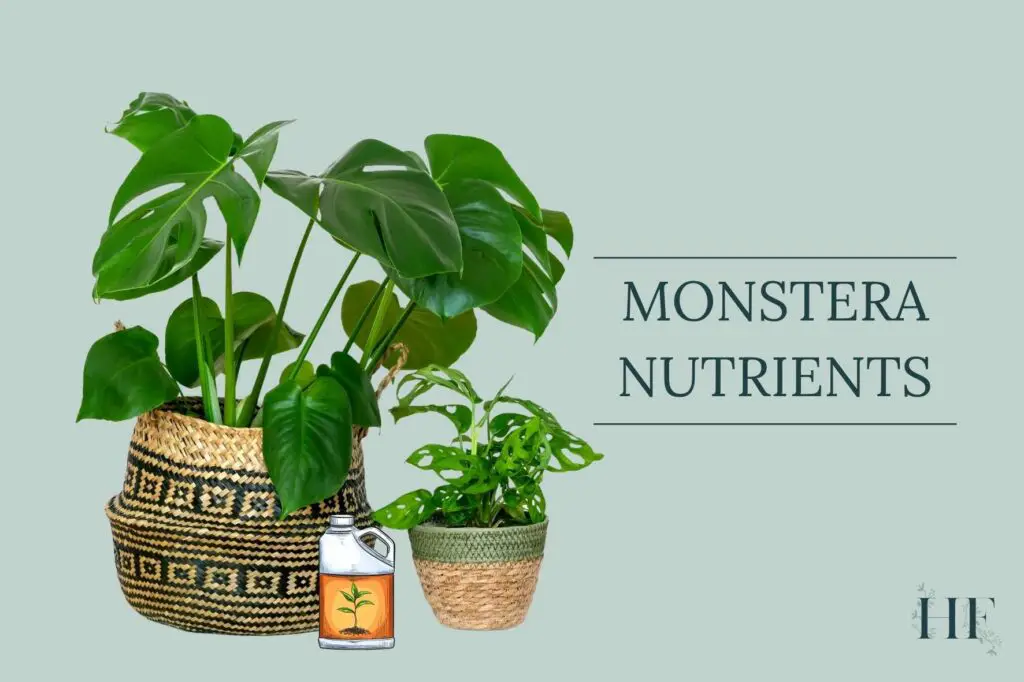

Hello Lily,
The information you shared was extremely helpful. I have two Monstera deliciosa one is about 30’ tall, the Thai constellation is about 13’ tall. I have been using miracle grow plant food with the ratio of 12,4,8. That is the same ratio as 3,1,2 but stronger. I didn’t know this information before reading your article. Excellent job.!!!!